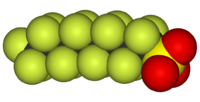
Photo from wikipedia
Perfluorooctanesulfonate (PFOS) is a persistent organic pollutant with significant bioaccumulation potential in liver tissues. Exposure to PFOS could cause increase of liver weight, induce adenomas of the liver, and cause… Click to show full abstract
Perfluorooctanesulfonate (PFOS) is a persistent organic pollutant with significant bioaccumulation potential in liver tissues. Exposure to PFOS could cause increase of liver weight, induce adenomas of the liver, and cause hepatomegaly. Alternatives of PFOS might be designed and synthesized that have significantly lower liver bioaccumulation. In this study, we conducted animal exposure experiments to investigate tissue accumulations of 14 per- and polyfluoroalkyl substances. Correlation analysis demonstrated that accumulation of the compounds in rat liver had strong correlations with their binding affinities of liver fatty acid binding protein (LFABP). Thus, we combined a quantitative structure-activity relationship model with molecular dynamics (MD) simulations to develop computational models to predict the LFABP binding affinities of two newly synthesized alternatives, perfluorodecalin-2-sulfonic acid and N-diperfluorobutanoic acid. The binding characteristics of the PFOS alternatives for LFABP were elaborated to explore how the different structural modifications of molecules influenced the underlying binding mechanisms. Subsequent animal experiments demonstrated that the binding free energy calculations based on the MD simulations provided a good indicator to reflect the relative degree of liver accumulation of the PFOS alternatives in the same exposure doses and durations. Our findings from the combination of experimental exposure and computational model can provide helpful information to design potential alternatives of PFOS with weak LFABP binding capability and low liver accumulation.
Journal Title: Environmental science & technology
Year Published: 2019
Link to full text (if available)
Share on Social Media: Sign Up to like & get
recommendations!